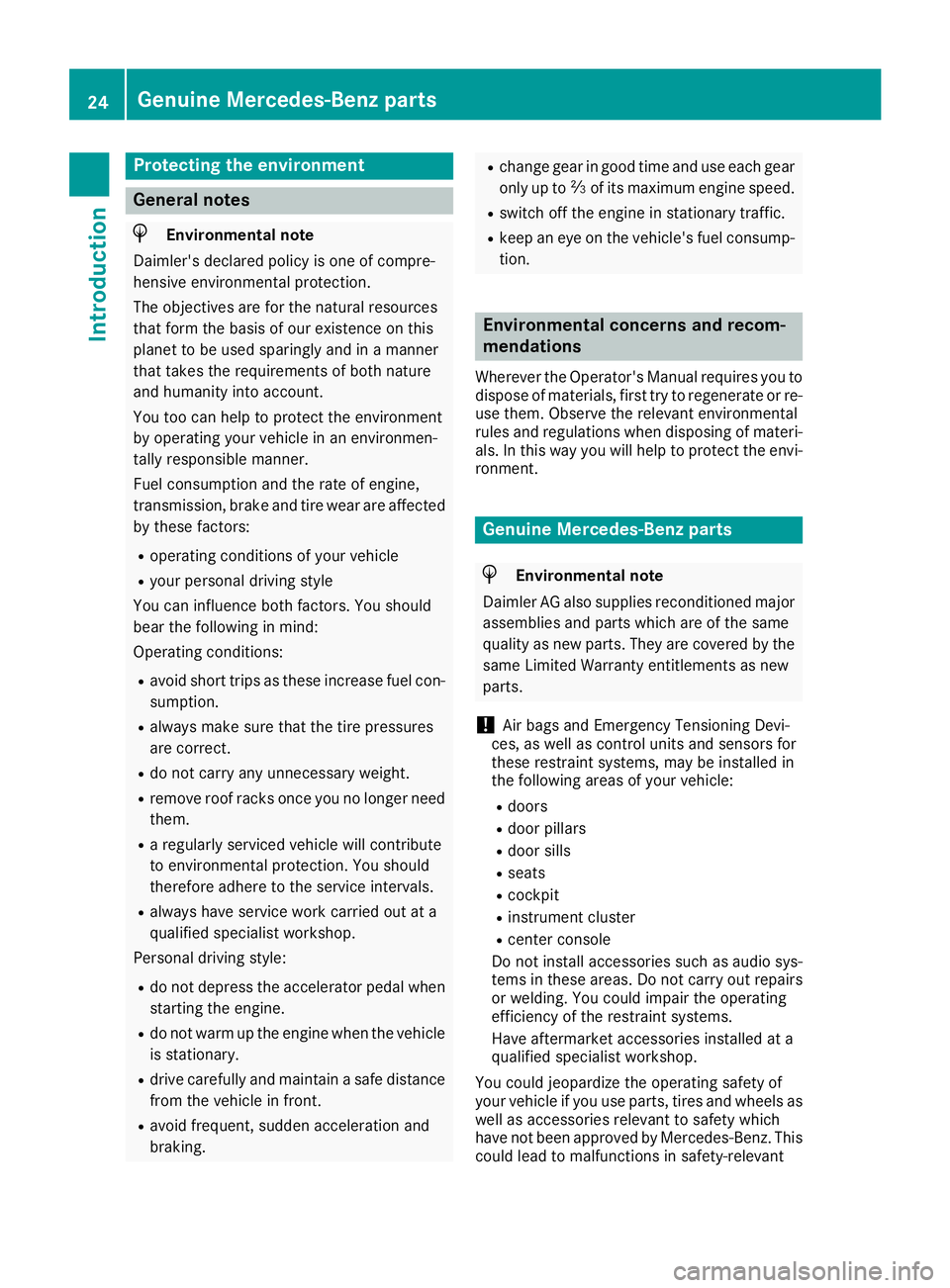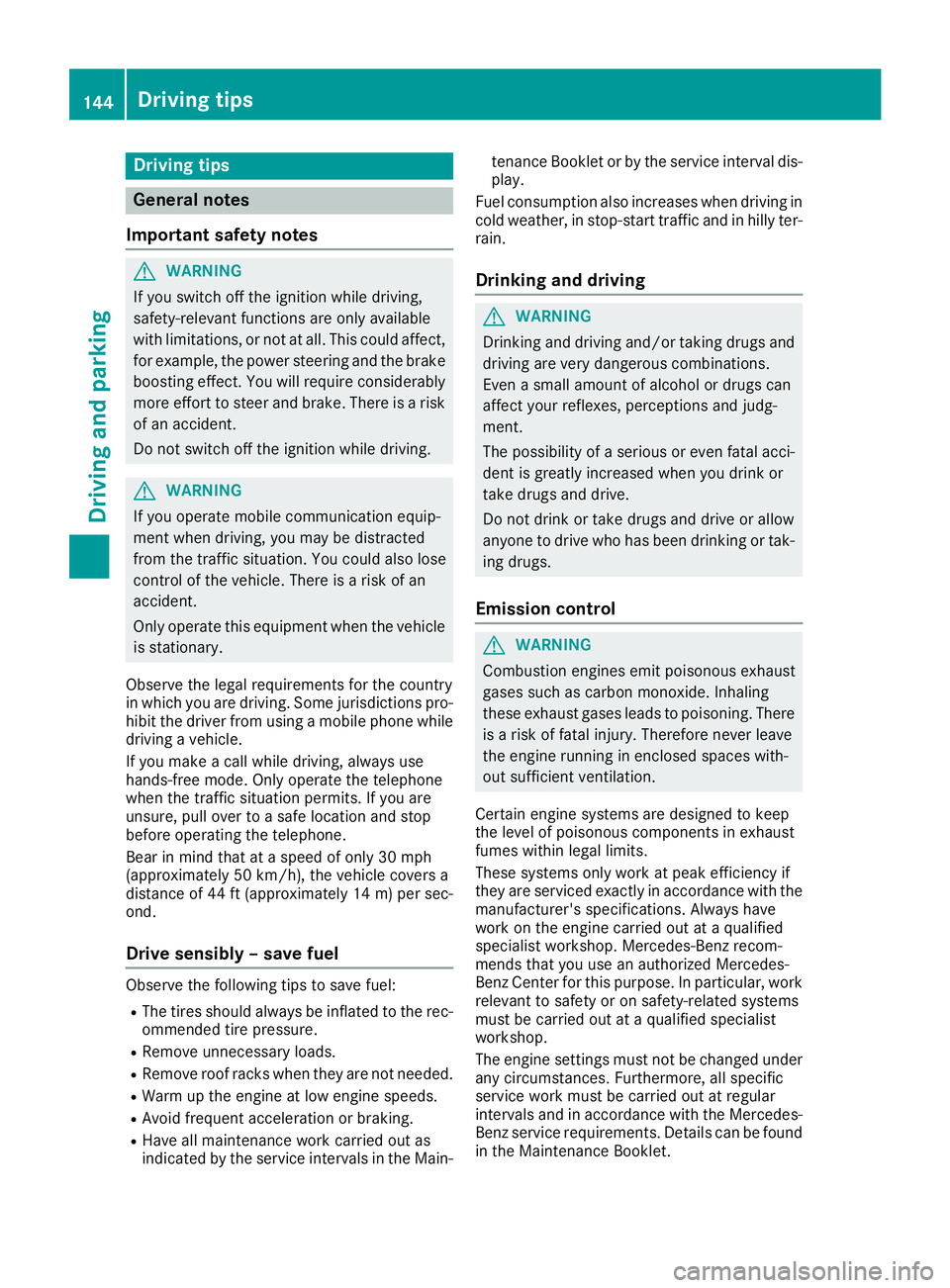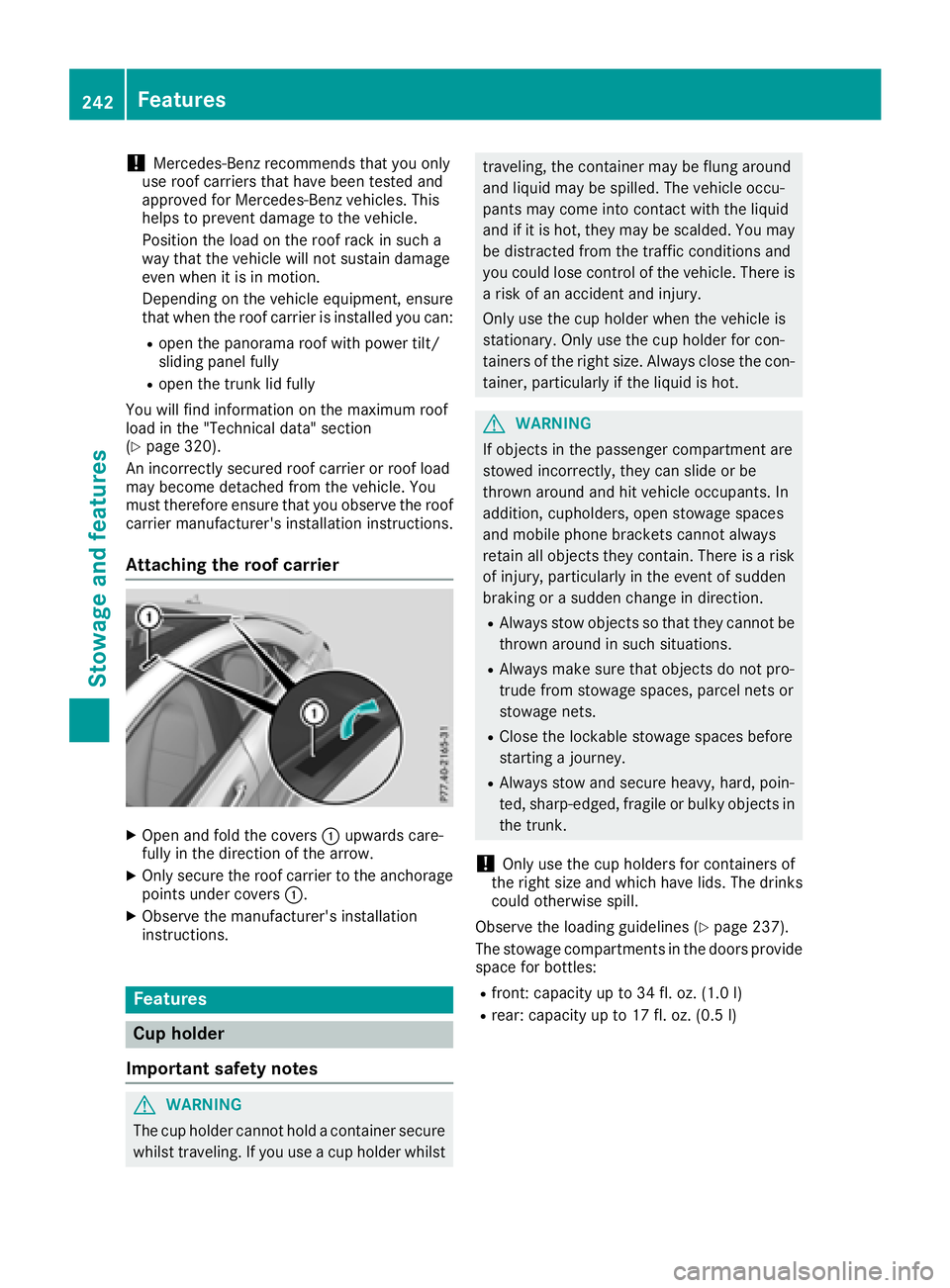2018 MERCEDES-BENZ CLA roof rack
[x] Cancel search: roof rackPage 26 of 326

Protecting the environment
General notes
H Environmental note
Daimler's declared policy is one of compre-
hensive environmental protection.
The objectives are for the natural resources
that form the basis of our existence on this
planet to be used sparingly and in am anner
that takes the requirements of both nature
and humanity into account.
You too can help to protect the environment
by operating your vehicle in an environmen-
tally responsible manner.
Fuel consumption and the rate of engine,
transmission, brake and tire wear are affected
by these factors: R
operating condition sofy our vehicleR
your personal driving style
You can influence both factors. You should
bear the following in mind:
Operating conditions: R
avoid short trips as these increase fuel con-
sumption. R
always make sure that the tire pressures
are correct. R
do not carry any unnecessary weight. R
remove roof racks once you no longer need
them. R
ar egularly serviced vehicle will contribute
to environmental protection. You should
therefore adhere to the service intervals. R
always have service work carried out at a
qualified specialist workshop.
Personal driving style: R
do not depress the accelerator pedal when
startin gt he engine.R
do not warm up the engine when the vehicle
is stationary. R
drive carefully and maintain as afe distance
from the vehicle in front. R
avoid frequent, sudden acceleration and
braking. R
change gear in good time and use each gear
only up to �
Page 146 of 326

Drivin gt ip s
General notes
Important safet yn otes
G WARNING
If you switch of ft he ignition whil ed riving,
safety-relevant function sa re only available
wit hl imitations, or no tata ll. Thi sc ou ld affect,
fo re xa mple, th ep owe rs te erin ga nd th eb rake
boostin ge ffect. You will require considerably
more effort to steer and brake .T here is ar is k
of an accident.
Do no ts witch of ft he ignition whil ed riving.
G WARNING
If you operat em ob ile communication equip -
men tw hen driving, you may be distracted
from th et ra ffic situation .Y ou could also los e
contro loft he vehicle. There is ar is kofa n
accident.
Only operat et hi se quipmen tw hen th ev ehicle
is stationary.
Observ et he lega lr equirements fo rt he country
in whic hy ou are driving. Some jurisdiction sp ro -
hibi tt he driver from usin gam ob ile phone whil e
drivin gav ehicle.
If you mak eac al lw hil ed riving, always use
hands-free mode. Only operat et he telephon e
when th et ra ffic situation permits. If you are
unsure ,p ull over to as af el ocation and stop
befor eo peratin gt he telephone.
Bear in min dt ha tatas peed of only 30 mph
(approximately 50 km/h), th ev ehicle cover sa
distanc eo f4 4f t( approximately 14 m) per sec-
ond.
Drive sensibly –s ave fuelObserve the following tips to save fuel: R
The tires should always be inflated to the rec-
ommended tire pressure. R
Remove unnecessary loads. R
Remove roof rack sw hen they are not needed.R
Warm up the engin eatl ow engin es peeds.R
Avoid frequen ta cceleration or braking.R
Have all maintenanc ew ork carried out as
indicated by the servic ei ntervals in the Main- tenance Booklet or by the servic ei nterval dis-
play.
Fuel consumption also increases when driving in
cold weather, in stop-start traffic and in hilly ter-
rain.
Drinking and driving
G WARNING
Drinkin ga nd driving and/or takin gd rugs and
driving are very dangerous combinations.
Even as mall amount of alcohol or drugs can
affect your reflexes, perceptions and judg-
ment.
The possibility of as erious or even fatal acci-
dent is greatly increased when you drink or
take drugs and drive.
Do not drink or take drugs and drive or allow
anyone to drive who has been drinking or tak-
ing drugs.
Emission control
G WARNING
Combustion engines emit poisonous exhaust
gases such as carbon monoxide. Inhaling
these exhaust gases leads to poisoning. There
is ar isk of fatal injury. Therefor en ever leave
the engin er unning in enclosed spaces with-
out sufficien tv entilation.
Certain engin es ystems are designed to keep
the level of poisonous component sine xhaust
fumes within legal limits.
These systems only work at peak efficiency if
they are serviced exactly in accordance with the
manufacturer's specifications .A lways have
work on the engin ec arried out at aq ualified
specialist workshop. Mercedes-Benz recom-
mends that you use an authorized Mercedes-
Ben zC enter for this purpose. In particular, work
relevant to safety or on safety-related systems
must be carried out at aq ualified specialist
workshop.
The engin es ettings must not be changed under
any circumstances. Furthermore, all specific
servic ew ork must be carried out at regular
intervals and in accordance with the Mercedes-
Ben zs ervic er equirements. Details can be found
in the Maintenance Booklet.144
Driving tips
Driving and parking
Page 244 of 326

! Mercedes-Benz recommends that you only
use roof carriers that have been tested and
approved for Mercedes-Benz vehicles. This
helps to prevent damage to the vehicle.
Position the load on the roof rack in such a
way that the vehicle will not sustain damage
even when it is in motion.
Depending on the vehicle equipment, ensure
that when the roof carrier is installed you can: R
open the panorama roof with power tilt/
sliding panel fully R
open the trunk lid fully
You will find information on the maximum roof
load in the "Technical data" section
( Y
page 320).
An incorrectly secured roof carrier or roof load
may become detached from the vehicle. You
must therefore ensure that you observe the roof
carrier manufacturer's installation instructions.
Attaching the roof carrier
X
Open and fold the covers �C upwards care-
fully in the direction of the arrow. X
Only secure the roof carrier to the anchorage
points under covers �C .X
Observe the manufacturer's installation
instructions.
Features
Cup holder
Important safety notes
G WARNING
The cup holder cannot hold ac ontainer secure
whilst traveling. If you use ac up holder whilst traveling, the container may be flung around
and liquid may be spilled. The vehicle occu-
pants may come into contact with the liquid
and if it is hot, they may be scalded. You may
be distracted from the traffic conditions and
you could lose control of the vehicle. There is
ar isk of an accident and injury.
Only use the cup holder when the vehicle is
stationary. Only use the cup holder for con-
tainers of the right size. Alway sc lose the con-
tainer, particularl yift he liquid is hot.
G WARNING
If objects in the passenger compartment are
stowed incorrectly, they can slide or be
thrown around and hit vehicle occupants. In
addition, cupholders, open stowage spaces
and mobile phone brackets cannot always
retain all objects they contain. There is ar isk
of injury, particularl yint he event of sudden
braking or as udden change in direction. R
Alway ss tow objects so that they cannot be
thrown around in such situations. R
Alway sm ake sure that objects do not pro-
trude from stowage spaces, parcel nets or
stowage nets. R
Close the lockable stowage spaces before
starting aj ourney. R
Alway ss tow and secure heavy, hard, poin-
ted, sharp-edged, fragile or bulky objects in
the trunk.
! Only use the cup holders for containers of
the right size and which have lids. The drinks
could otherwise spill.
Observe the loading guidelines ( Y
page 237).
The stowage compartment sint he doors provide
space for bottles: R
front :c apacity up to 34 fl. oz. (1.0 l)R
rear: capacity up to 17 fl. oz. (0.5 l)242
Features
Stowage and features